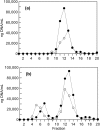Identification of anthraquinone-degrading bacteria in soil contaminated with polycyclic aromatic hydrocarbons
- PMID: 25819957
- PMCID: PMC4421061
- DOI: 10.1128/AEM.00033-15
Identification of anthraquinone-degrading bacteria in soil contaminated with polycyclic aromatic hydrocarbons
Abstract
Quinones and other oxygenated polycyclic aromatic hydrocarbons (oxy-PAHs) are toxic and/or genotoxic compounds observed to be cocontaminants at PAH-contaminated sites, but their formation and fate in contaminated environmental systems have not been well studied. Anthracene-9,10-dione (anthraquinone) has been found in most PAH-contaminated soils and sediments that have been analyzed for oxy-PAHs. However, little is known about the biodegradation of oxy-PAHs, and no bacterial isolates have been described that are capable of growing on or degrading anthraquinone. PAH-degrading Mycobacterium spp. are the only organisms that have been investigated to date for metabolism of a PAH quinone, 4,5-pyrenequinone. We utilized DNA-based stable-isotope probing (SIP) with [U-(13)C]anthraquinone to identify bacteria associated with anthraquinone degradation in PAH-contaminated soil from a former manufactured-gas plant site both before and after treatment in a laboratory-scale bioreactor. SIP with [U-(13)C]anthracene was also performed to assess whether bacteria capable of growing on anthracene are the same as those identified to grow on anthraquinone. Organisms closely related to Sphingomonas were the most predominant among the organisms associated with anthraquinone degradation in bioreactor-treated soil, while organisms in the genus Phenylobacterium comprised the majority of anthraquinone degraders in the untreated soil. Bacteria associated with anthracene degradation differed from those responsible for anthraquinone degradation. These results suggest that Sphingomonas and Phenylobacterium species are associated with anthraquinone degradation and that anthracene-degrading organisms may not possess mechanisms to grow on anthraquinone.
Copyright © 2015, American Society for Microbiology. All Rights Reserved.
Figures


Similar articles
-
Sphingomonas from petroleum-contaminated soils in Shenfu, China and their PAHs degradation abilities.Braz J Microbiol. 2016 Apr-Jun;47(2):271-8. doi: 10.1016/j.bjm.2016.01.001. Epub 2016 Mar 2. Braz J Microbiol. 2016. PMID: 26991271 Free PMC article.
-
Bacterial community dynamics and polycyclic aromatic hydrocarbon degradation during bioremediation of heavily creosote-contaminated soil.Appl Environ Microbiol. 2005 Nov;71(11):7008-18. doi: 10.1128/AEM.71.11.7008-7018.2005. Appl Environ Microbiol. 2005. PMID: 16269736 Free PMC article.
-
Differential responses of eubacterial, Mycobacterium, and Sphingomonas communities in polycyclic aromatic hydrocarbon (PAH)-contaminated soil to artificially induced changes in PAH profile.J Environ Qual. 2007 Aug 31;36(5):1403-11. doi: 10.2134/jeq2006.0471. Print 2007 Sep-Oct. J Environ Qual. 2007. PMID: 17766819
-
Electrokinetic-Enhanced Remediation of Phenanthrene-Contaminated Soil Combined with Sphingomonas sp. GY2B and Biosurfactant.Appl Biochem Biotechnol. 2016 Apr;178(7):1325-38. doi: 10.1007/s12010-015-1949-8. Epub 2015 Dec 18. Appl Biochem Biotechnol. 2016. PMID: 26683200 Review.
-
Sphingomonads in Microbe-Assisted Phytoremediation: Tackling Soil Pollution.Trends Biotechnol. 2017 Sep;35(9):883-899. doi: 10.1016/j.tibtech.2017.06.014. Epub 2017 Jul 20. Trends Biotechnol. 2017. PMID: 28736087 Review.
Cited by
-
Succession of microbial populations and nitrogen-fixation associated with the biodegradation of sediment-oil-agglomerates buried in a Florida sandy beach.Sci Rep. 2019 Dec 18;9(1):19401. doi: 10.1038/s41598-019-55625-6. Sci Rep. 2019. PMID: 31852991 Free PMC article.
-
Enzymatic Bioremediation of Organophosphate Compounds-Progress and Remaining Challenges.Front Bioeng Biotechnol. 2019 Nov 8;7:289. doi: 10.3389/fbioe.2019.00289. eCollection 2019. Front Bioeng Biotechnol. 2019. PMID: 31781549 Free PMC article. Review.
-
Influence of Extremely High Pressure and Oxygen on Hydrocarbon-Enriched Microbial Communities in Sediments from the Challenger Deep, Mariana Trench.Microorganisms. 2023 Mar 1;11(3):630. doi: 10.3390/microorganisms11030630. Microorganisms. 2023. PMID: 36985204 Free PMC article.
-
Multi-Omic Profiling of a Newly Isolated Oxy-PAH Degrading Specialist from PAH-Contaminated Soil Reveals Bacterial Mechanisms to Mitigate the Risk Posed by Polar Transformation Products.Environ Sci Technol. 2023 Jan 10;57(1):139-149. doi: 10.1021/acs.est.2c05485. Epub 2022 Dec 14. Environ Sci Technol. 2023. PMID: 36516361 Free PMC article.
-
Isolation, genetic identification and degradation characteristics of COD-degrading bacterial strain in slaughter wastewater.Saudi J Biol Sci. 2018 Dec;25(8):1800-1805. doi: 10.1016/j.sjbs.2018.08.022. Epub 2018 Aug 23. Saudi J Biol Sci. 2018. PMID: 30591803 Free PMC article.
References
-
- Meyer S, Cartellieri S, Steinhart H. 1999. Simultaneous determination of PAHs, hetero-PAHs (N, S, O), and their degradation products in creosote-contaminated soils. Method development, validation, and application to hazardous waste sites. Anal Chem 71:4023–4029.
-
- Wilcke W, Bandowe BAM, Lueso MG, Ruppenthal M, del Valle H, Oelmann Y. 2014. Polycyclic aromatic hydrocarbons (PAHs) and their polar derivatives (oxygenated PAHs, azaarenes) in soils along a climosequence in Argentina. Sci Total Environ 473-474:317–325. doi:10.1016/j.scitotenv.2013.12.037. - DOI - PubMed
Publication types
MeSH terms
Substances
Grants and funding
LinkOut - more resources
Full Text Sources
Molecular Biology Databases
Miscellaneous

